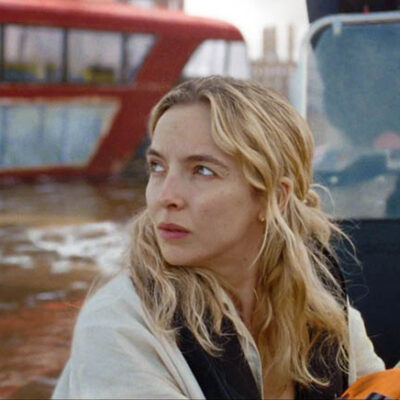CHAOS CONTINUES: THE AIRLOCK
At one point the passengers realize that the crew of the Avenue 5 are in fact actors, and they mistakenly believe they are all on a reality TV show instead of in outer space. When some try to leave the airlock of the ship, they are instantly frozen, an effect handled by Nviz. This began with on-set capture.
“After the initial on-set shoot had finished, the actors were asked to try and match their ‘freeze’ pose again for the photogrammetry process,” outlines Nviz CG Supervisor Sam Churchill. “Once processed, the geo needed some cleaning, but due to the nature of the final effect, any ‘blobby-ness’ that comes from even the highest quality photogrammetry could be used to sell the ice/frosting layer. The textures were then balanced to better match the lighting in the shot rather than the lighting in the photo scan booth, and we had a set of high-quality digi-doubles ready for use.”
The initial idea for the sequence was that the freeze effect would happen mainly off-screen during the reaction shots, enabling Nviz to give a simpler nod towards the effect in 2D on the actual freeze pose shots. This meant the poses did not need to be exactly the same, with the cut-away enabling Nviz to go from plate to CG without any concern about seeing a slight hand movement between the two slightly-off poses.
“However,” notes Churchill, “after putting the sequence together myself, Production Visual Effects Supervisor Simon Frame really wanted to push the frosting effect into the first freeze shots. In order to achieve this we had to take the photogrammetry of each actor and line them up through the camera so that the geo and the plate matched perfectly. Then by projecting that plate back onto the geo and adding the frosting layer over the top we were able to get the final look working and ensure the sequence then tied together without the need for any off-camera tricks.”
The final look was achieved by creating an ice layer over the characters. Continues Churchill, “We duplicated the geo, applied the raw photogrammetry texture to the base geo and applied a very high frequency displacement map to the outer ‘ice/frosting’ layer with an ice shader set to capture reflection from the digitally recreated set and also refract the raw color from the layer underneath. The beauty of doing it this way meant we had a very accurate output from the ray-traced scene, we had an effective slider for how much or little frosting we wanted and were also able to animate the displacement to make it feel like it is growing over the skin.”























